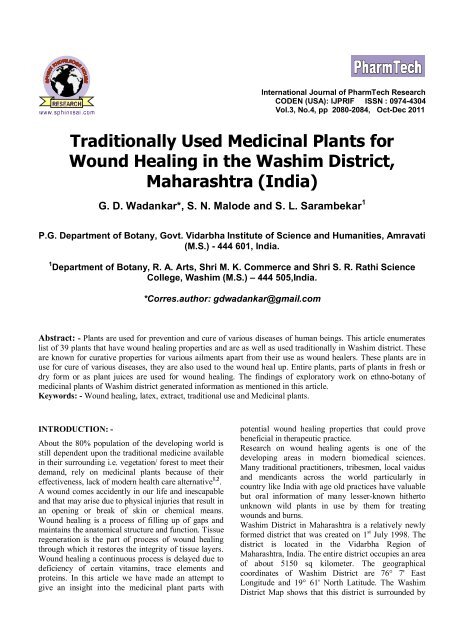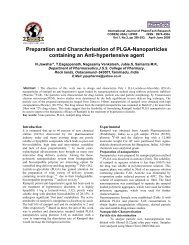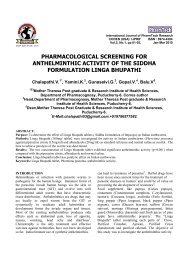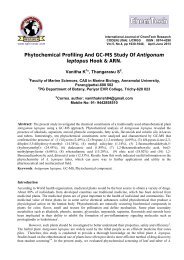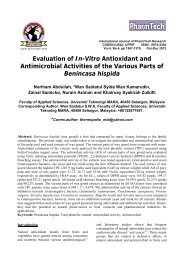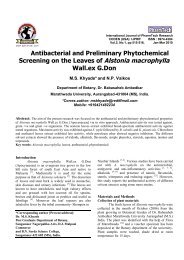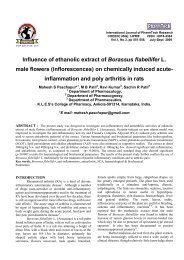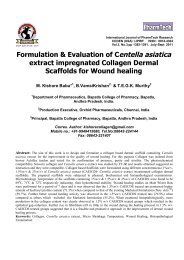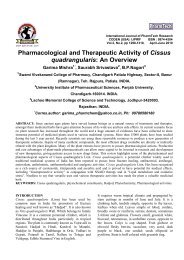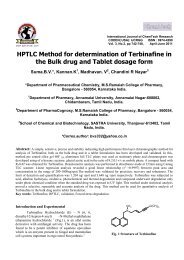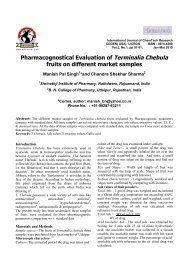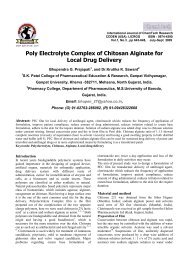Traditionally Used Medicinal Plants for Wound Healing in the ...
Traditionally Used Medicinal Plants for Wound Healing in the ...
Traditionally Used Medicinal Plants for Wound Healing in the ...
You also want an ePaper? Increase the reach of your titles
YUMPU automatically turns print PDFs into web optimized ePapers that Google loves.
International Journal of PharmTech Research<br />
CODEN (USA): IJPRIF ISSN : 0974-4304<br />
Vol.3, No.4, pp 2080-2084, Oct-Dec 2011<br />
<strong>Traditionally</strong> <strong>Used</strong> <strong>Medic<strong>in</strong>al</strong> <strong>Plants</strong> <strong>for</strong><br />
<strong>Wound</strong> <strong>Heal<strong>in</strong>g</strong> <strong>in</strong> <strong>the</strong> Washim District,<br />
Maharashtra (India)<br />
G. D. Wadankar*, S. N. Malode and S. L. Sarambekar 1<br />
P.G. Department of Botany, Govt. Vidarbha Institute of Science and Humanities, Amravati<br />
(M.S.) - 444 601, India.<br />
1 Department of Botany, R. A. Arts, Shri M. K. Commerce and Shri S. R. Rathi Science<br />
College, Washim (M.S.) – 444 505,India.<br />
*Corres.author: gdwadankar@gmail.com<br />
Abstract: - <strong>Plants</strong> are used <strong>for</strong> prevention and cure of various diseases of human be<strong>in</strong>gs. This article enumerates<br />
list of 39 plants that have wound heal<strong>in</strong>g properties and are as well as used traditionally <strong>in</strong> Washim district. These<br />
are known <strong>for</strong> curative properties <strong>for</strong> various ailments apart from <strong>the</strong>ir use as wound healers. These plants are <strong>in</strong><br />
use <strong>for</strong> cure of various diseases, <strong>the</strong>y are also used to <strong>the</strong> wound heal up. Entire plants, parts of plants <strong>in</strong> fresh or<br />
dry <strong>for</strong>m or as plant juices are used <strong>for</strong> wound heal<strong>in</strong>g. The f<strong>in</strong>d<strong>in</strong>gs of exploratory work on ethno-botany of<br />
medic<strong>in</strong>al plants of Washim district generated <strong>in</strong><strong>for</strong>mation as mentioned <strong>in</strong> this article.<br />
Keywords: - <strong>Wound</strong> heal<strong>in</strong>g, latex, extract, traditional use and <strong>Medic<strong>in</strong>al</strong> plants.<br />
INTRODUCTION: -<br />
About <strong>the</strong> 80% population of <strong>the</strong> develop<strong>in</strong>g world is<br />
still dependent upon <strong>the</strong> traditional medic<strong>in</strong>e available<br />
<strong>in</strong> <strong>the</strong>ir surround<strong>in</strong>g i.e. vegetation/ <strong>for</strong>est to meet <strong>the</strong>ir<br />
demand, rely on medic<strong>in</strong>al plants because of <strong>the</strong>ir<br />
effectiveness, lack of modern health care alternative 1,2 .<br />
A wound comes accidently <strong>in</strong> our life and <strong>in</strong>escapable<br />
and that may arise due to physical <strong>in</strong>juries that result <strong>in</strong><br />
an open<strong>in</strong>g or break of sk<strong>in</strong> or chemical means.<br />
<strong>Wound</strong> heal<strong>in</strong>g is a process of fill<strong>in</strong>g up of gaps and<br />
ma<strong>in</strong>ta<strong>in</strong>s <strong>the</strong> anatomical structure and function. Tissue<br />
regeneration is <strong>the</strong> part of process of wound heal<strong>in</strong>g<br />
through which it restores <strong>the</strong> <strong>in</strong>tegrity of tissue layers.<br />
<strong>Wound</strong> heal<strong>in</strong>g a cont<strong>in</strong>uous process is delayed due to<br />
deficiency of certa<strong>in</strong> vitam<strong>in</strong>s, trace elements and<br />
prote<strong>in</strong>s. In this article we have made an attempt to<br />
give an <strong>in</strong>sight <strong>in</strong>to <strong>the</strong> medic<strong>in</strong>al plant parts with<br />
potential wound heal<strong>in</strong>g properties that could prove<br />
beneficial <strong>in</strong> <strong>the</strong>rapeutic practice.<br />
Research on wound heal<strong>in</strong>g agents is one of <strong>the</strong><br />
develop<strong>in</strong>g areas <strong>in</strong> modern biomedical sciences.<br />
Many traditional practitioners, tribesmen, local vaidus<br />
and mendicants across <strong>the</strong> world particularly <strong>in</strong><br />
country like India with age old practices have valuable<br />
but oral <strong>in</strong><strong>for</strong>mation of many lesser-known hi<strong>the</strong>rto<br />
unknown wild plants <strong>in</strong> use by <strong>the</strong>m <strong>for</strong> treat<strong>in</strong>g<br />
wounds and burns.<br />
Washim District <strong>in</strong> Maharashtra is a relatively newly<br />
<strong>for</strong>med district that was created on 1 st July 1998. The<br />
district is located <strong>in</strong> <strong>the</strong> Vidarbha Region of<br />
Maharashtra, India. The entire district occupies an area<br />
of about 5150 sq kilometer. The geographical<br />
coord<strong>in</strong>ates of Washim District are 76° 7' East<br />
Longitude and 19° 61' North Latitude. The Washim<br />
District Map shows that this district is surrounded by
G.D.Wadankar et al /Int.J. PharmTech Res.2011,3(4) 2081<br />
Akola, Amravati, Buldhana, Yavatmal and Parbhani<br />
districts. The temperature varies from 9 o C to 45 o C<br />
and <strong>the</strong> annual ra<strong>in</strong>fall is about 832 mm, hous<strong>in</strong>g<br />
pockets of deciduous <strong>for</strong>ests rich <strong>in</strong> medic<strong>in</strong>al plants.<br />
The present study is thus an attempt to document<br />
different plant varieties that are used by <strong>the</strong><br />
communities of Washim district, Maharashtra <strong>in</strong><br />
wound heal<strong>in</strong>g treatments.<br />
MATERIAL AND METHODS: -<br />
The <strong>in</strong><strong>for</strong>mation about <strong>the</strong> medic<strong>in</strong>al plants used by <strong>the</strong><br />
local peoples of Washim district <strong>in</strong> wound heal<strong>in</strong>g was<br />
obta<strong>in</strong>ed from tribesmen, local vaidus and medic<strong>in</strong>al<br />
herb stores. The collected <strong>in</strong><strong>for</strong>mation was ma<strong>in</strong>ly<br />
related to plant parts used with quantity and vernacular<br />
names. The plants were collected and identified<br />
technically. The plants identified that, plant parts with<br />
rang<strong>in</strong>g vernacular name, often named differently,<br />
often confus<strong>in</strong>g as <strong>the</strong> same products were named<br />
differently. The botanical names, family were<br />
identified from <strong>the</strong> books, Wealth of India, <strong>in</strong>ternet<br />
and etc. The botanical names are arranged<br />
alphabetically. The parts of plants used <strong>for</strong> medic<strong>in</strong>al<br />
preparations vary from leaves, stem barks, seeds, roots,<br />
fruits and flowers respectively as mentioned <strong>in</strong> Table<br />
No 1.<br />
The <strong>in</strong><strong>for</strong>mation generated was ascerta<strong>in</strong>ed by<br />
referr<strong>in</strong>g floras and earlier publications.<br />
Table: 1 List of <strong>the</strong> <strong>Medic<strong>in</strong>al</strong> plants used <strong>for</strong> <strong>Wound</strong> heal<strong>in</strong>g. Scientific names of <strong>the</strong> medic<strong>in</strong>al<br />
plants are arranged <strong>in</strong> alphabetical order<br />
Sr.<br />
No.<br />
Botanical Name Vernacular Name Family Part <strong>Used</strong><br />
1 Acacia catechu Willd Khair Mimosaceae Bark<br />
2 Acalypha <strong>in</strong>dica L. Kuppi Euphorbiaceae Whole plant<br />
3 Achyran<strong>the</strong>s aspera L. Aghada Amranthaceae Leaves<br />
4 Aloe vera (L.) Burm. f. Korphad Liliaceae Leaf juice<br />
5 Annona squamosa L. Sitaphal Annonaceae Leaf<br />
6 Argemone maxicana L. Pili / Piwala Papavaraceae Leaves and<br />
Dhotra/ R<strong>in</strong>gani<br />
latex<br />
7 Azadirachta <strong>in</strong>dica Juss Neem Meliaceae Leaves<br />
8 Butea monosperma<br />
(Lamk.)<br />
Palas Fabaceae bark<br />
9 Bombax ceiba L. Kateshevar Bombacaceae bark<br />
10 Brassica juncea L. Mohari Brassicaceae Fruits<br />
11 Bryophyllum calyc<strong>in</strong>um<br />
Salisb.<br />
Panfuti Crassulaceae Leaf<br />
12 Caesalp<strong>in</strong>ia bonduc L. Sagar Gota Caesalp<strong>in</strong>iaceae Fruit<br />
13 Calotropis procera (Ait.) Rui Asclepiadaceae Leaves and<br />
R. Br.<br />
latex<br />
14 Carica papaya L. Papai Caricaceae Fruit Extract<br />
15 Colocasia esculenta (L.)<br />
Schott<br />
Alu Araceae Leaf extract<br />
16 Commiphora mukul Hook Guggule Burseraceae Whole Plant<br />
17 Costus speciosus Koenig. Penva,<br />
Pushkarmula<br />
Costaceae Root<br />
18 Curcuma longa L. Halad Z<strong>in</strong>giberaceae Rhizome,<br />
Seeds<br />
19 Daucas carota L. Gajar Apiaceae Root<br />
20 Erythr<strong>in</strong>a varaegata L. Pangara Fabaceae Leaf<br />
21 Euphorbia hirta L. Dudhi Euphorbiaceae Whole Plant<br />
22 Ficus religiosa L. Pimpal Moraceae Bark<br />
23 Gloroisa superba L. Kal-lawi Liliaceae Leaves<br />
24 Jatropha gossypifolia L. Chandan jyoti Euphorbiaceae Whole plant
G.D.Wadankar et al /Int.J. PharmTech Res.2011,3(4) 2082<br />
25 Lantana camara L. Ghaneri Verbenaceae<br />
latex<br />
Leaf juice<br />
26 Lawsonia <strong>in</strong>nnermis alba Mehdi Lythraceae Leaves, Seeds,<br />
L.<br />
Bark and<br />
Flowers.<br />
27 Mimosa pudica L. Lajalu Mimosaceae Leaves<br />
28 Mor<strong>in</strong>ga oleifera Lamk. Shewaga Mor<strong>in</strong>gaceae Leaves<br />
29 Nerium <strong>in</strong>dicum Mill. Kaneri Apocyanaceae Leaves<br />
30 Ocimum sanctum L. Tulsi Labiatae Leaves<br />
31 Phyllanthus emblica L. Awala Euphorbiaceae Whole plant<br />
32 Punica granatum L. Dalimb Punicaceae Peels<br />
33 Ric<strong>in</strong>us communis L. Erand Euphorbiaceae Whole Plant<br />
34 Semecarpus anacardium<br />
L. f.<br />
Bibba Anacardiaceae Fruits<br />
35 Term<strong>in</strong>alia arjuna<br />
(Roxb.) Wight & Arn<br />
Arjun Combretaceae Bark<br />
36 Tridax procrumbens L. Tongal modi / Asteraceae Leaves, Whole<br />
Dagadi Pala<br />
plant<br />
37 Trigonella foenumgraecum<br />
L.<br />
Methi Fabaceae Seeds<br />
38 Withania somnifera<br />
Dunal.<br />
Ashwagandha Solanaceae Root, Seeds<br />
39 Z<strong>in</strong>giber offic<strong>in</strong>ale Rosc Adrak Z<strong>in</strong>giberaceae Rhizome<br />
Figure 1: Different parts of <strong>the</strong> plants used by <strong>the</strong> people accord<strong>in</strong>g to <strong>the</strong>ir<br />
preference <strong>for</strong> wound heal<strong>in</strong>g.<br />
RESULT: -<br />
A total number of 39 plant species have been recorded<br />
used <strong>in</strong> <strong>the</strong> treatment <strong>for</strong> wound heal<strong>in</strong>g. The parts<br />
utilized are listed <strong>in</strong> <strong>the</strong> table No.1. The list mentioned<br />
is as a representation of prelim<strong>in</strong>ary works, an<br />
exhaustive list will be f<strong>in</strong>alized with<strong>in</strong> a span of 3<br />
years of survey and sampl<strong>in</strong>g.<br />
We have presented such plants which are extensively<br />
used <strong>in</strong> traditional medic<strong>in</strong>e of India and have been<br />
ethno-botanical references corroborate oral<br />
<strong>in</strong><strong>for</strong>mation from local tribesmen/ vaidus.<br />
Although traditional medic<strong>in</strong>es offer a safe,<br />
<strong>in</strong>expensive approach to treatment of wounds and<br />
burns, it has not received adequate attention.<br />
There are a number of plants which have been reported<br />
<strong>for</strong> <strong>the</strong>ir wound heal<strong>in</strong>g activity. Most of <strong>the</strong>se studies<br />
<strong>in</strong>volve random screen<strong>in</strong>g of plant or extracts <strong>for</strong><br />
wound heal<strong>in</strong>g activity, while some of <strong>the</strong> plants<br />
enumerated <strong>in</strong> Table No. 1 have been
G.D.Wadankar et al /Int.J. PharmTech Res.2011,3(4) 2083<br />
pharmacologically validated <strong>for</strong> <strong>the</strong>ir wound heal<strong>in</strong>g<br />
activity viz. Aloe vera 3,4 , Azadirachta <strong>in</strong>dica 5 , Carica<br />
papaya 6 , Curcuma longa 7 , Ocimum sanctum 8 ,<br />
Phyllanthus emblica 9 , Term<strong>in</strong>alia arjuna 10 .<br />
A number of secondary metabolites / active<br />
compounds isolated from plants have been<br />
demonstrated <strong>in</strong> animal models (<strong>in</strong> vivo) as active<br />
pr<strong>in</strong>ciples responsible <strong>for</strong> facilitat<strong>in</strong>g heal<strong>in</strong>g of<br />
wounds. Some of <strong>the</strong> most important ones <strong>in</strong>clude<br />
tann<strong>in</strong>s from Term<strong>in</strong>alia arjuna 10 , glycoprote<strong>in</strong><br />
fraction from Aloe vera 11 .<br />
Among <strong>the</strong> different plant parts documented and<br />
utilized, highest proportion (37.78%) was of leaves,<br />
followed by whole plant (16 %), bark (13.33%), fruit<br />
(8.9%), seeds (8.9%), root (6.67%), rhizome (4.44%),<br />
flower (2.22%) and peels (2.22%) depicted <strong>in</strong> <strong>the</strong><br />
figure 1.<br />
The oil obta<strong>in</strong>ed from dried fruits of Semecarpus<br />
anacardium is applied over newly wounded area of <strong>the</strong><br />
body to avoid water contact, seal<strong>in</strong>g <strong>the</strong> surface and<br />
helps <strong>in</strong> wound heal<strong>in</strong>g. Dur<strong>in</strong>g <strong>the</strong> survey it was also<br />
noted that besides wound heal<strong>in</strong>g properties<br />
Semecarpus anacardium is also used <strong>for</strong> obta<strong>in</strong><strong>in</strong>g<br />
black dye and a source of natural dye.<br />
Commiphora mukul is also used as <strong>in</strong>cense and as a<br />
fixative <strong>in</strong> perfumery. Besides wound heal<strong>in</strong>g<br />
properties, some plants are poisonous too e.g. Gloroisa<br />
superba, Calotropis procera, Withania somnifera.<br />
Withania somnifera are also widely used <strong>for</strong> cur<strong>in</strong>g<br />
diabetes and ailments <strong>in</strong> addition to wound heal<strong>in</strong>g.<br />
REFERENCES:<br />
1. Sandhya B., Thomas S., Isabel W. and<br />
Shenbagarathai R., Ethnomedic<strong>in</strong>al <strong>Plants</strong> used<br />
by <strong>the</strong> Valaiyan Community of Pairanmalai Hills<br />
(Reserved Forest), Tamilnadu, India- A Pilot<br />
Study, African Journal of Traditional,<br />
Complementary and Alternative Medic<strong>in</strong>es,<br />
2006, 3(1), 101-114.<br />
2. Caniago I. and Siebert S., <strong>Medic<strong>in</strong>al</strong> plants<br />
ecology, knowledge and conservation <strong>in</strong><br />
Kalimantan, Indonesia, Eco. Bot, 1998, 52, 229-<br />
250.<br />
3. Heggers J. P., Kucukcelibi A., Listengarten D.,<br />
Stabenau C.J., Ko F., Broemel<strong>in</strong>g L.D., Robson<br />
M.C. and W<strong>in</strong>ters W.D., Beneficial effect of<br />
Aloe on wound heal<strong>in</strong>g <strong>in</strong> an excision wound<br />
model, Journal of Alternative and<br />
Complementary Medic<strong>in</strong>e, 1996, 2, 271–277.<br />
4. Davis R.H., Leitner M.G., Russo J.M. and Byrne<br />
M.E., <strong>Wound</strong> heal<strong>in</strong>g. Oral and topical activity<br />
Z<strong>in</strong>giber offic<strong>in</strong>ale and Curcuma longa belongs to <strong>the</strong><br />
family z<strong>in</strong>giberaceae are most commonly used <strong>for</strong> <strong>the</strong>ir<br />
medic<strong>in</strong>al value. <strong>Traditionally</strong>, <strong>the</strong> paste from <strong>the</strong><br />
rhizomes are applied as a remedy <strong>for</strong> <strong>in</strong>flamed jo<strong>in</strong>ts<br />
and spra<strong>in</strong>s along with wounds, bruises 12 . Calotropis<br />
procera leaves are smoked to cure asthma and cough,<br />
<strong>the</strong> latex is commonly used <strong>for</strong> r<strong>in</strong>gworm, dog bites<br />
thorn <strong>in</strong>juries, sk<strong>in</strong> diseases and <strong>in</strong> tann<strong>in</strong>g <strong>in</strong>dustry.<br />
Lawsonia <strong>in</strong>nnermis alba seeds of <strong>the</strong> herb are used <strong>in</strong><br />
dysentery. Bark of <strong>the</strong> herb is used <strong>in</strong> jaundice. Henna<br />
leaves are used <strong>in</strong> baldness and prickly heat powder.<br />
Henna leaves are used <strong>in</strong> boils and burns. <strong>Used</strong> <strong>in</strong> hair<br />
dyes, oil is used <strong>in</strong> perfume <strong>in</strong>dustry.<br />
These f<strong>in</strong>d<strong>in</strong>gs give credence to <strong>the</strong> traditional<br />
medic<strong>in</strong>al application of <strong>the</strong> plant as remedies <strong>for</strong><br />
measles, <strong>in</strong>ternal and external wounds and <strong>in</strong>fections.<br />
DISCUSSION: -<br />
Traditional knowledge of herbal medic<strong>in</strong>e is<br />
disappear<strong>in</strong>g which should be conserved and will give<br />
<strong>the</strong> base l<strong>in</strong>e <strong>in</strong><strong>for</strong>mation <strong>for</strong> <strong>the</strong> chemist to discover<br />
new drug. This is one of <strong>the</strong> steps taken towards <strong>the</strong><br />
document<strong>in</strong>g treasures of <strong>in</strong>digenous knowledge upon<br />
<strong>the</strong> wound heal<strong>in</strong>g property of medic<strong>in</strong>al plants. There<br />
is an urgent need <strong>for</strong> proper collection of <strong>the</strong> medic<strong>in</strong>al<br />
plants from Washim district.<br />
Thus, <strong>the</strong> major aim of <strong>the</strong> current article is to identify<br />
and project <strong>the</strong> plants especially of Indian orig<strong>in</strong> which<br />
have potential to emerge as modern drug substitutes.<br />
of Aloe vera, Journal American Podiatric<br />
Medical Association, 1989, 79, 559–562.<br />
5. Bharadwaj R.L. and Sharma D.N., Evaluation of<br />
neem (Azadirachta <strong>in</strong>dica Juss) oil as a potent<br />
wound healer. Histomorphological and<br />
histochemical study, Indian Veter<strong>in</strong>ary Medical<br />
Journal, 1997, 21, 187–190.<br />
6. Mikhalchik E.V., Ivanova A.V., Anurov M.V.,<br />
Titkova S.M., Penkov L.Y., Kharaeva Z.F. and<br />
Kork<strong>in</strong>a L.G., <strong>Wound</strong>-heal<strong>in</strong>g effect of papayabased<br />
preparation <strong>in</strong> experimental <strong>the</strong>rmal<br />
trauma, Bullet<strong>in</strong> of Experimental Biology and<br />
Medic<strong>in</strong>e, 2004, 137, 560–562.<br />
7. Mehra K.S., Mikuni I., Gupta U. and Gode K.D.,<br />
Curcuma longa (L<strong>in</strong>n) drops <strong>in</strong> corneal wound<br />
heal<strong>in</strong>g Tokai, Journal Experimental Cl<strong>in</strong>ical<br />
Medic<strong>in</strong>e, 1984, 9, 27 -31.<br />
8. Udupa S.L., Shetty S., Udupa A.L. and Somayaji<br />
S.N., Effect of Ocimum sanctum L<strong>in</strong>n. on<br />
normal and dexamethasone suppressed wound
G.D.Wadankar et al /Int.J. PharmTech Res.2011,3(4) 2084<br />
heal<strong>in</strong>g, Indian Journal of Experimental Biology,<br />
2006, 44, 49–54.<br />
9. Suguna L., Sumitra M. and Chandrakasan G.,<br />
Influence of Phyllanthus emblica extract on<br />
dermal wound heal<strong>in</strong>g <strong>in</strong> rats, Journal of<br />
<strong>Medic<strong>in</strong>al</strong> and Aromatic <strong>Plants</strong>, 2000, 32, 2–3.<br />
10. Chaudhari M. and Mengi S., Evaluation of<br />
phytoconstituents of Term<strong>in</strong>alia arjuna <strong>for</strong><br />
wound heal<strong>in</strong>g activity <strong>in</strong> rats, Phyto<strong>the</strong>rapy<br />
Research, 2006, 20, 799–805.<br />
11. Choi S.W., Son B.W., Son Y.S., Park Y.I., Lee<br />
S.K. and Chung M.H., The wound heal<strong>in</strong>g effect<br />
of a glycoprote<strong>in</strong> fraction isolated from Aloe<br />
vera, British Journal of Dermatology, 2001, 145,<br />
535–545.<br />
12. Eigner D. and Scholz D., Ferula asa-foetida and<br />
Curcuma longa <strong>in</strong> traditional medic<strong>in</strong>e<br />
treatement and diet <strong>in</strong> Nepal, J. Ethnopharmacol,<br />
1999, 67, 1-6.<br />
*****


